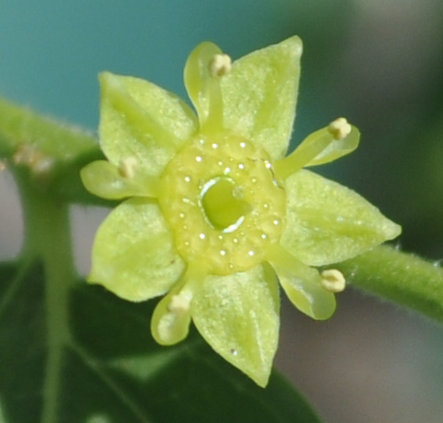Photo Journal: Anatomy of a Jujube Flower
Back here were lots of pretty pictures of jujube flowers, but not exactly much in the way of information as to what you were looking at.
As with that week, this week is another time-poor one I’m afraid. But while this post will also be photo-heavy, it won’t be as light on the words, and you may even be tempted to wander outside to examine your own flowers (jujubes or otherwise!) by the end of it!
Let’s first look at a stylised diagram of the parts of a flower. The flower in that illustration is a perfect flower — to botanists, that means it’s a bisexual or hermaphroditic flower, with both male and female organs, and able to reproduce on its own. More specifically, a perfect flower is one that:
- makes and distributes male gametes (male sex cells, or pollen, the equivalent of sperm in animals)
- makes female gametes (female sex cells, or ovules, the equivalent of unfertilised eggs in animals)
- receives male gametes (pollen) able to fertilise the female gametes (ovules)
The third point is crucial as it is this capability that makes a perfect flower able to fertilise itself (though often with the help of pollinators such as insects or birds). Making male and female gametes is one thing, but if an ovule can’t then receive the pollen from its own flower, then that flower cannot fertilise itself.
I’m mentioning all this of course, because jujube flowers themselves are perfect flowers. Here’s a close-up of one. With reference to the stylised diagram, can you pick out the sepals, petals, anthers, filaments, bifurcated (branched) style and stigmas/stigmata (plural forms for stigma) in the jujube rootstock flower below?
(What you may think is the ovary is actually a nectary disc, which is above the (covered) ovary. See how it glistens with nectar?)

© Optimate Group Pty Ltd
Here’s a different angle, of a Chico flower (this one’s nectary disc has finished secreting nectar):

© Optimate Group Pty Ltd
How’d you go?

© Optimate Group Pty Ltd
Probably the trickiest part is distinguishing those ever so tiny, delicate spoon-like petals from the petal-like sepals! You have to really look hard to notice them. And you have to look harder again to even notice the tiny anthers and filaments, which practically merge into the background and look like part of the petals at a casual glance.
It’s the sepals we see folded into the distinctive pentagonal shape of the flower buds:

© Optimate Group Pty Ltd
And there you have it, the anatomy of a jujube flower — you’ll never mistake sepals for petals again, will you?!
And so as not to leave you hanging, here is a spent flower with the nectary disc and now visible ovary:

© Optimate Group Pty Ltd
About the Author
BSc(Hons), U.Syd. - double major in biochemistry and microbiology, with honours in microbiology
PhD, U.Syd - soil microbiology
Stumbled into IT and publishing of all things.
Discovered jujube trees and realised that perhaps I should have been an agronomist...
So I combined all the above passions and interests into this website and its blog and manuals, on which I write about botany, soil chemistry, soil microbiology and biochemistry - and yes, jujubes too!
Please help me buy a plant if you found this article interesting or useful!